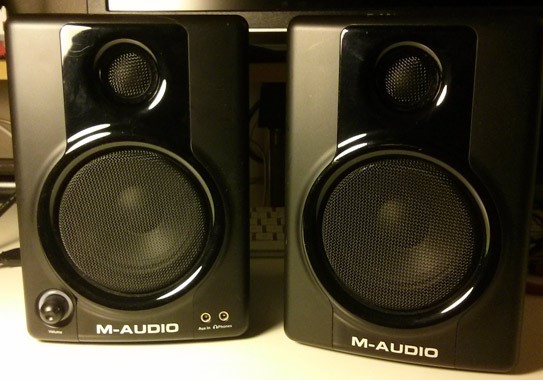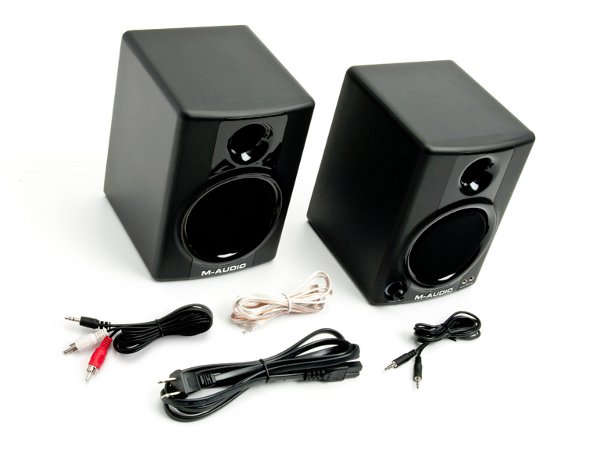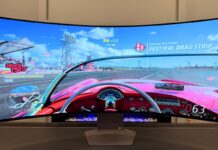 Over the years, M-Audio has carved out a large niche for itself in the home, project and bedroom studio market. The company boasts a product line that includes audio and MIDI interfaces, keyboard and alternate MIDI controllers, headphones, microphones, accessories and of course speakers.
Over the years, M-Audio has carved out a large niche for itself in the home, project and bedroom studio market. The company boasts a product line that includes audio and MIDI interfaces, keyboard and alternate MIDI controllers, headphones, microphones, accessories and of course speakers.
M-Audio Studiophile AV 30’s are positioned as a cross-over (media consumer to media creator) product on their website:
“If you want to go beyond enjoying music and videos to creating your own, you need a serious speaker system with accurate sound.”
Technology these days makes the barriers to getting your creative feet wet lower than they were a decade ago. The AV 30’s are being positioned to be a part of that lower barrier.
The 411 on the AV 30’s
 The Studiophile AV 30’s are magnetically shielded and are 7.9 inches tall, 5.3 inches wide, and 6.3 inches deep. The speakers are rear-ported and are made of vinyl-coated, medium-density fiberboard (MDF). Each speaker sports a 3-inch polypropylene-coated woofer and a 1-inch, fluid-cooled, silk dome tweeter, with a crossover point at 3.3 KHz. The woofer and tweeter each have black-metal grilles protecting them. The system provides 20 Watts of total power (10 Watts per channel).
The Studiophile AV 30’s are magnetically shielded and are 7.9 inches tall, 5.3 inches wide, and 6.3 inches deep. The speakers are rear-ported and are made of vinyl-coated, medium-density fiberboard (MDF). Each speaker sports a 3-inch polypropylene-coated woofer and a 1-inch, fluid-cooled, silk dome tweeter, with a crossover point at 3.3 KHz. The woofer and tweeter each have black-metal grilles protecting them. The system provides 20 Watts of total power (10 Watts per channel).
All of the important stuff – amplification, ports, and controls – are on the left speaker. The right speaker is passive, and is connected to the left by a very thin piece of speaker wire (included). The right speaker obviously weighs less than the left speaker – the pair weighs just under 12 pounds.
The rear of the left speaker has two RCA inputs, connections to the right speaker, a power switch and the bass-reflex port. Pretty simple.
The front of the speaker sports a blue volume knob encircled by a blue LED that glows when the speakers are powered on. There is an ⅛ inch aux-in jack and headphone out jack on the front panel.
 In Use
In Use
Setting up the speakers is quite simple. M-Audio provides a stereo ⅛ inch mini-to-RCA cable in addition to a six foot length of speaker wire. You can use any length / gauge of speaker wire which gives you more flexibility in how and where you want to place the speakers in your setup.
I didn’t mind listening to the speakers in a passive mode. For their size and power, they delivered a good punch and stereo image for someone listening in a small room or apartment. The ported design of the speakers allows them to add some thump to more bass-heavy programs, but nothing that will cause neighbours to call authorities.
When critically listening to these speakers, I can’t say that I’d trust them for mixing. The bottom end cuts off at 90 Hz (I’m being generous) and the higher frequencies being produced seem to taper off from 10 kHZ and up causing the speakers to lose the air and shimmer in programs I’m used to.
When cranking the volume on the AV 30’s, you’re not going to easily attract the ire of your neighbours, but I was pleased to find that the MDF construction of the speakers dampened distortion you’d expect from other speakers in this price range.
I liked that the volume knob was on the front of the left speaker and that there is an aux input along with a headphone output there too. I have a beef with a lot of powered speaker manufacturers that place the power switch on the back – the AV 30’s are no exception to that beef.
 Final Thoughts
Final Thoughts
If you are looking for an inexpensive “C” pair of speakers to reference mixes on or something small and portable to take with your mobile rig, then take a look at the AV 30’s. These are a great set of speakers for general use with a computer—video games, videos and passively listening to music.
They’re definitely not going to replace higher-priced studio monitors and I wouldn’t use them as my main reference speakers. For professionals, the perfect use for these would be for editing audio on a laptop away from the studio.
The M-Audio Studiophile AV 30 ‘s don’t sound bad at all for the price, so check them out if you’re in need of an extra set.



